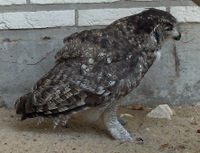Spotted Eagle Owl
Conservation status Least concern |

|
|
Scientific classification |
| Kingdom: |
Animalia
|
| Phylum: |
Chordata
|
| Class: |
Aves
|
| Order: |
Strigiformes
|
| Family: |
Strigidae
|
| Genus: |
Bubo
|
| Species: |
B. africanus
|
|
|
Binomial name |
Bubo africanus
Temminck, 1821 |
Spotted Eagle Owl (Bubo africanus) is a
species of the
Horned owls. It is a medium sized
owl
and one of the smallest of the
Eagle owls. Its height is forty-five cm (18 inch) and its
weight is from 480 to 850g (1 to 1.8 pounds). They have a
33cm (13 in) wing span. The facial disk is off white to a
pale ochre and the eyes are yellow. They have prominent ear
tufts and the upper body is dusky brown with lower parts off
white with brown bars. Prior to 1999 the Spotted Eagle owl
was classed as a subspecies with the Vermiculated Eagle Owl but is now classed as a separate
species. They are carnivorous and their prey consists of
small mammals, birds, insects and reptiles.
Habitat
They inhabit most of
Africa south of the Sahara desert away from dense forests. They are
nocturnal hunters spending the day concealed in trees, rock
ledges or abandoned burrows. They are found in areas with
rocky outcroppings, scrub land open woods and semi deserts.
Spotted eagle owls do not avoid populated areas. They will
often hunt near roads and are often struck by vehicles. The
major cause of death is pesticides used in agriculture for
insect and rodent control.
Reproduction
Spotted eagle owls mate for life. They are able to breed
at around one year of age. They make their nest on the
ground and have been known to nest on window ledges of
buildings. Breeding begins in July continuing to the first
weeks February. The female lays two to four eggs and she
does the incubation leaving the nest only to eat what the
male has brought food. The incubation period lasts
approximately thirty two days. The young owls can fly at
around seven weeks of age. Five weeks later at twelve weeks
the young owls leave the nest. They have a life span of up
to ten years in the wild and up to twenty in captivity.
References
- BirdLife International (2004).
Bubo africanus. 2006 IUCN Red List of
Threatened Species. IUCN 2006. Retrieved on 11 May 2006. Database entry
includes justification for why this species is of least
concern
External links




